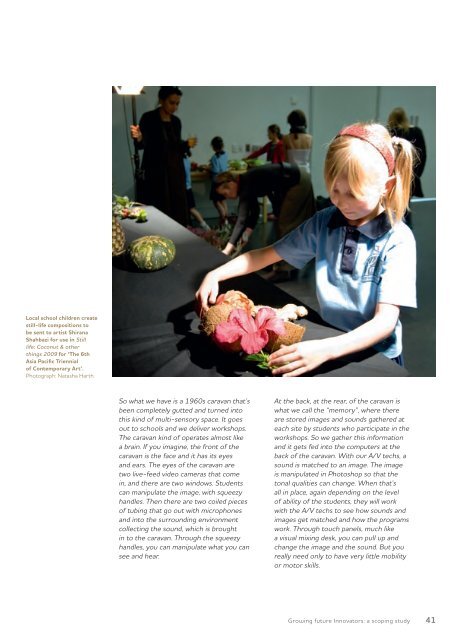GrowinG Future innovators - ARC Centre of Excellence for Creative ...
GrowinG Future innovators - ARC Centre of Excellence for Creative ...
GrowinG Future innovators - ARC Centre of Excellence for Creative ...
Create successful ePaper yourself
Turn your PDF publications into a flip-book with our unique Google optimized e-Paper software.
Local school children create<br />
still-life compositions to<br />
be sent to artist Shirana<br />
Shahbazi <strong>for</strong> use in Still<br />
life: Coconut & other<br />
things 2009 <strong>for</strong> ‘The 6th<br />
Asia Pacific Triennial<br />
<strong>of</strong> Contemporary Art’.<br />
Photograph: Natasha Harth.<br />
So what we have is a 1960s caravan that’s<br />
been completely gutted and turned into<br />
this kind <strong>of</strong> multi-sensory space. It goes<br />
out to schools and we deliver workshops.<br />
The caravan kind <strong>of</strong> operates almost like<br />
a brain. If you imagine, the front <strong>of</strong> the<br />
caravan is the face and it has its eyes<br />
and ears. The eyes <strong>of</strong> the caravan are<br />
two live-feed video cameras that come<br />
in, and there are two windows. Students<br />
can manipulate the image, with squeezy<br />
handles. Then there are two coiled pieces<br />
<strong>of</strong> tubing that go out with microphones<br />
and into the surrounding environment<br />
collecting the sound, which is brought<br />
in to the caravan. Through the squeezy<br />
handles, you can manipulate what you can<br />
see and hear.<br />
At the back, at the rear, <strong>of</strong> the caravan is<br />
what we call the “memory”, where there<br />
are stored images and sounds gathered at<br />
each site by students who participate in the<br />
workshops. So we gather this in<strong>for</strong>mation<br />
and it gets fed into the computers at the<br />
back <strong>of</strong> the caravan. With our A/V techs, a<br />
sound is matched to an image. The image<br />
is manipulated in Photoshop so that the<br />
tonal qualities can change. When that’s<br />
all in place, again depending on the level<br />
<strong>of</strong> ability <strong>of</strong> the students, they will work<br />
with the A/V techs to see how sounds and<br />
images get matched and how the programs<br />
work. Through touch panels, much like<br />
a visual mixing desk, you can pull up and<br />
change the image and the sound. But you<br />
really need only to have very little mobility<br />
or motor skills.<br />
Growing future Innovators: a scoping study 41




![Plebiscite (Riegert chapter) revised FINAL [Feb 14].pdf](https://img.yumpu.com/8710373/1/190x245/plebiscite-riegert-chapter-revised-final-feb-14pdf.jpg?quality=85)